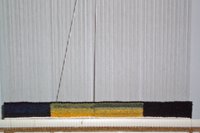 The hem is done and was done quite quickly. I ended up doing three slits and wove the hem in four sections. I experimented with about ten color combinations in the two middle sections. I kept the black on the sides to blend in with the black which will be on the right side of the piece. The potential colors look great and I am excited to move forward. There was little pull in. Looks like the piece will be about 22 1/2 inches wide.
The hem is done and was done quite quickly. I ended up doing three slits and wove the hem in four sections. I experimented with about ten color combinations in the two middle sections. I kept the black on the sides to blend in with the black which will be on the right side of the piece. The potential colors look great and I am excited to move forward. There was little pull in. Looks like the piece will be about 22 1/2 inches wide.I am now deciding whether to use a row of soumak or not between the hem and the rest of the weaving. I often do that since I had heard it was a good way to make sure the warp stays covered when the tapestry is folded at the top and bottom. I also remember somewhere that perhaps more than one row is good.
Yesterday afternoon I flipped through the Carol Russell Tapestry Handbook I read a few pages here or there looking for guidance. This morning I took a different approach, I let my left brain do the searching -found the index which told me the actual page for information on hems - found my answer.
Here is what it said:
'Hemming is another aspect of tapestry finishing about which there are many
theories...A favorite method of many weavers is to weave about 1 " of solid
tapestry background above the first heading, then a row of soumak knots marking
the actual edge of the tapestry. This highly recommended method,
duplicated at both ends of a tapestry, results in perfectly even hems,
well-concealed headings, two uniform edges, and the flattest possible folds in a
heavy textile.'
Oh yes! One row of soumak coming up. Who wouldn't want their hems described as 'perfectly even'... 'well-concealed'...'uniform' ... and the 'flattest possible'?
1 comment:
Thank you for actually looking up the hem info, CFS - and for encouraging me to think about what I'm doing too. Your loom looks luscious in action!
Post a Comment